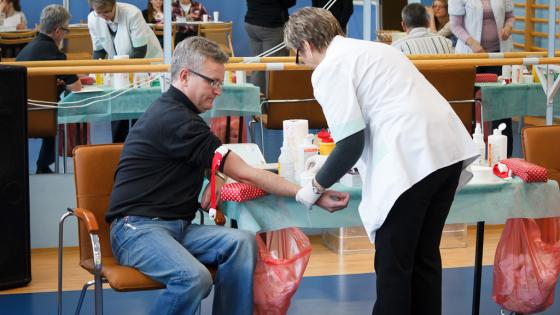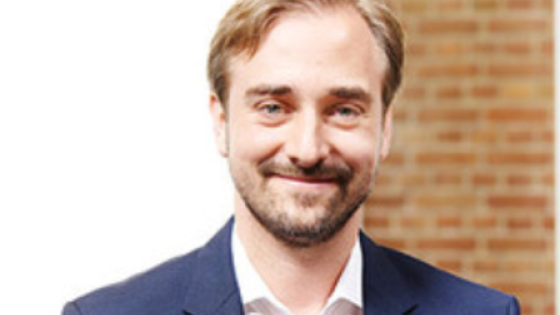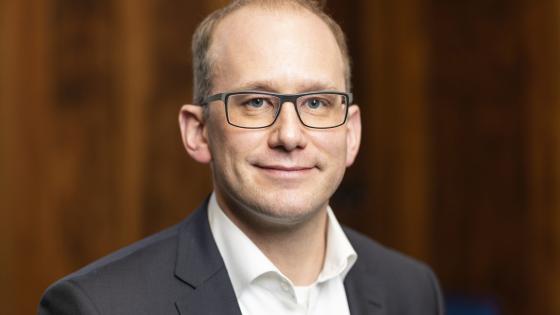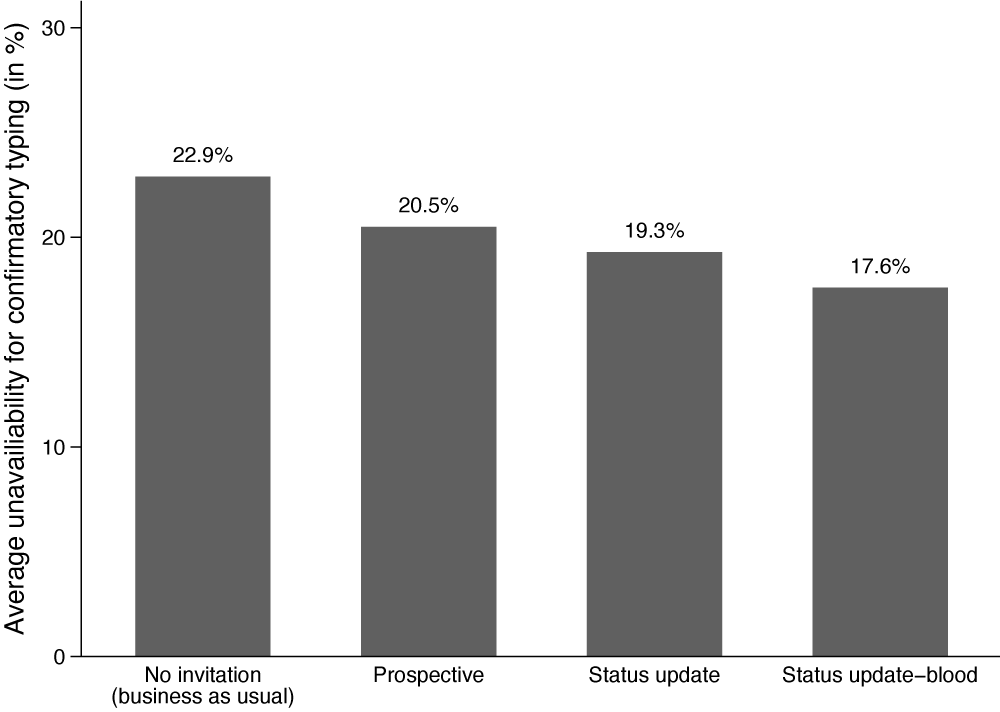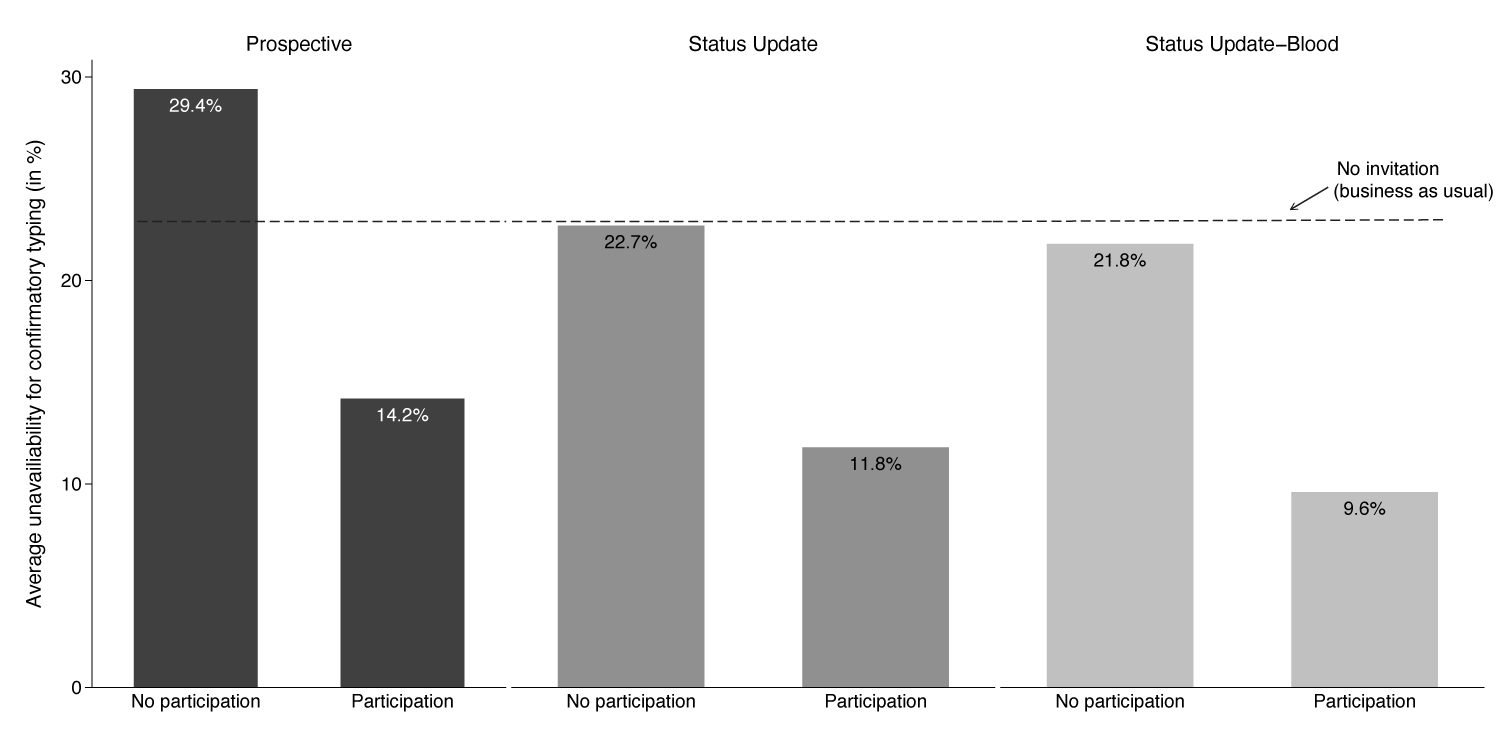For patients suffering from leukaemia or other blood diseases, a hematopoietic stem cell transplantation from a matching, unrelated donor frequently offers the best chance of survival. However, the unavailability of potential stem cell donors who have already joined a donor registry is a critical challenge, hampering the donation process and, consequentially, reducing the chance of survival for many patients (e.g. Gratwohl et al. 2015).
Unlike other medical donations, a stem cell donation is a multi-stage process (e.g. Bergstrom et al. 2009). First, potential donors sign up to a stem cell donor registry and provide the preliminary medical information used for determining who they might donate to. Second, registry members may be contacted weeks, months, or even years later if they are a possible biological match for a patient. If contacted, they will receive a request for ‘confirmatory typing’ from a transplant centre to determine whether they are in fact genetically and medically suitable for a hematopoietic stem cell transplantation. This mandatory confirmatory typing step is the decisive point for the potential donor to decide whether to follow through with the donation. Third, if they are a match and agree to donate, the transplantation occurs.
Upon registering, potential donors make a non-binding commitment to donate stem cells sometime in the future. Hence, the donation process is characterised by uncertainty about whether and when a donation opportunity will materialise. This unique setup makes commitment problems on the side of the donors more likely, as it differs from other medical contributions such as blood donations, which occur immediately following the commitment (e.g. Lacetera and Macis 2008, Lacetera et al. 2012).
The donor tendency to not follow through on their non-binding commitment (i.e. attrition) at the confirmatory-typing stage is a considerable problem for stem cell donor registries around the world. In Western countries, attrition ranges from 23% to 56% (e.g. Lown et al. 2014, Anthias et al. 2020). Attrition delays the process of finding suitable donors and increases the waiting time for many transplants, which might negatively affect patient survival rates. Thus, it is crucial for donor registry managers to understand how initiatives to collect additional information from donors affect their likelihood to follow through with the donation process.
In our study (Haylock et al. 2022), we analyse a set of initiatives implemented by DKMS Germany, a leading stem cell donor registry with more than 11 million registered donors, that attempt to address this challenge. The initiatives target individuals who have signed up to the donor registry but have not yet been selected for a confirmatory typing, and have the potential to impact a donor’s commitment. Participation in the initiatives involves some costly action. For example, the registry asks members to send in biological material via buccal swab, to draw blood for genetic retyping, and/or to report dates of long absences in advance.
Specifically, we examine three of DKMS’ initiatives: ‘prospective’, which requests retyping of potential donors; ‘status update’, which asks potential donors to report dates of unavailability (e.g. due to pregnancy or stays abroad); and ‘status update-blood’, which requests retyping via blood draw and asks donors to report their unavailability. While the initiatives vary in terms of donors’ efforts, they all aim to reduce delays at the confirmatory typing stage.
We analysed 91,479 requests for confirmatory typing issued to potential donors registered with DKMS Germany between 2013 and 2018. Our data include donor-related and registry-related information that DKMS uses to determine whether registry members are invited to participate in the initiatives.
We first examined whether the invitations themselves affected registry members’ willingness to be available for confirmatory typing, regardless of whether they accepted the invitation. We do this by comparing the percentage of individuals who were unavailable among those who were and were not invited to each initiative. Given how DKMS chose individuals to invite into the initiatives, and given a wealth of information about each individual, we were able to compare individuals who were invited to an initiative with otherwise identical individuals who did not receive an invitation.
We further examined whether the group of individuals who chose to participate in the initiatives were less likely to be unavailable than the DKMS registry members who did not receive an invitation to any initiative. This group of initiative participants can no longer be considered identical to those who did not get an invitation, since they have signalled to DKMS by joining an initiative that they are more motivated to help. And this is the point: these initiatives not only give DKMS useful information from the updated health and availability information, but also help DKMS identify more motivated registry members.
Invitation effect of initiatives (‘direct’ effect)
Our analyses show that unconditional on their actual participation in the initiatives, donors’ unavailability at the confirmatory typing stage was substantially lower for potential donors who had been invited to one of the initiatives than for non-invitees. Figure 1 shows the average level of unavailability for each initiative and for those who were not invited to any initiative: on average, 22.9% of registry members who were not invited to an initiative were unavailable when asked to follow up with confirmatory typing, whereas only 17.6 of registry members invited to participate in the ‘status update-blood’ were unavailable.
Figure 1 Unavailability of potential donors for confirmatory typing by initiative, unconditional on participation in an initiative (sample averages)
Source: Haylock et al. (2022)
In our formal statistical analyses, we needed to ‘adjust’ for differences between registry members who did and did not receive an initiative invitation. After these adjustments, our statistical analyses indicate that the availability of donors invited to the initiatives, which involved retyping (status update-blood and prospective) were 3.2 and 2.5 percentage points (pp), respectively, higher than of those who received no invitation (both significant at the one-percent level). Since the unavailability at the confirmatory typing stage for members who did not get an invitation was 22.9%, the lower unavailability of members who received the ‘status update-blood’ and ‘prospective’ invitations corresponds to a 14.0% (3.2/22.9) and 10.9% (2.5/22.9) reduction in unavailability, respectively. However, asking for additional information without retyping (status update) did not significantly affect donors’ availability.
Initiative participants are more likely to follow through (‘predictive’ effect)
Participation in an initiative strongly reduces donors’ unavailability at the confirmatory typing stage. For all initiatives, Figure 2 shows that, on average, donors who choose to participate are substantially less likely to be unavailable for confirmatory typing than non-participants.
Figure 2 Unavailability of potential donors for confirmatory typing by initiative, conditional on participation in an initiative (sample averages)
Source: Haylock et al. (2022)
After addressing differences between participants and non-participants, our analyses indicate that the retyping initiative (prospective) and the retyping plus blood-draw initiative (status update-blood) led to a 4.3 and 8.2 percentage point higher availability, respectively (both highly statistically significant) compared to registry members who did not receive an initiative invitation. Participating in the ‘status update’ initiative increased availability by 3.8 percentage points, but this estimated effect was not statistically significant. Thus, compared to registry members who did not receive an invitation to an initiative, registry members who participated in the initiatives were between 16.6% (3.8/22.9) and 35.8% (8.2/22.9) less likely to be unavailable, which indicates a significant improvement on finding a stem cell donor more quickly.
Our findings on the effects of initiatives commonly conducted by stem cell donor registries yield practical insights for the management of these registries. In particular, the link between unavailability for confirmatory typing and registered donors’ participation in an initiative is positive and large in magnitude. This represents a valuable opportunity for registries to employ such initiatives to more quickly and successfully find available donors.
Further, a donor’s decision to participate in an initiative that requires updating information yields practical information to the registry which would otherwise not be available. Based on reported periods of future absence of participating donors, for example, the registry can avoid wasting time trying to reach these donors during times they are unavailable. This makes the donation process more efficient (i.e. notably faster). As a consequence, donor registries should be given the opportunity to make such information available to search coordinators and transplant centres. These insights could help managers of donor registries motivate potential donors to follow through with their donations.
References
Anthias, C, B E Shaw, J G Bruce, D L Confer, L K Abress, M A Dew, A Billen, A O’Leary, H Braund and G E Switzer (2020), “Role of race/ethnicity in donor decisions about unrelated hematopoietic progenitor cell donation: Exploring reasons for higher attrition among racial/ethnic minorities”, Biology of Blood and Marrow Transplantation 26(3): 593–599.
Bergstrom, T C, R J Garratt and D Sheehan-Connor (2009), “One chance in a million: Altruism and the bone marrow registry”, American Economic Review 99(4): 1309–34.
Gratwohl, A, M C Pasquini, M Aljurf, Y Atsuta, H Baldomero, L Foeken, M Gratwohl, L F Bouzas, D Confer, K Frauendorfer et al. (2015), “One million haemopoietic stem-cell transplants: a retrospective observational study”, Lancet Haematology 2(3): e91–e100.
Haylock, M, P Kampkötter, M Macis, J Sauter, S Seitz, R Slonim, D Wiesen and A H Schmidt (2022), “Improving the availability of unrelated stem cell donors: Evidence from a major donor registry”, NBER Working Paper 29857.
Lacetera, N and M Macis (2008), “Incentives for altruism? The case of blood donations”, VoxEU.org, 4 November.
Lacetera, N, M Macis and R Slonim (2012), “Will there be blood? Incentives and displacement effects in pro-social behavior”, American Economic Journal: Economic Policy 4(1): 186–223.
